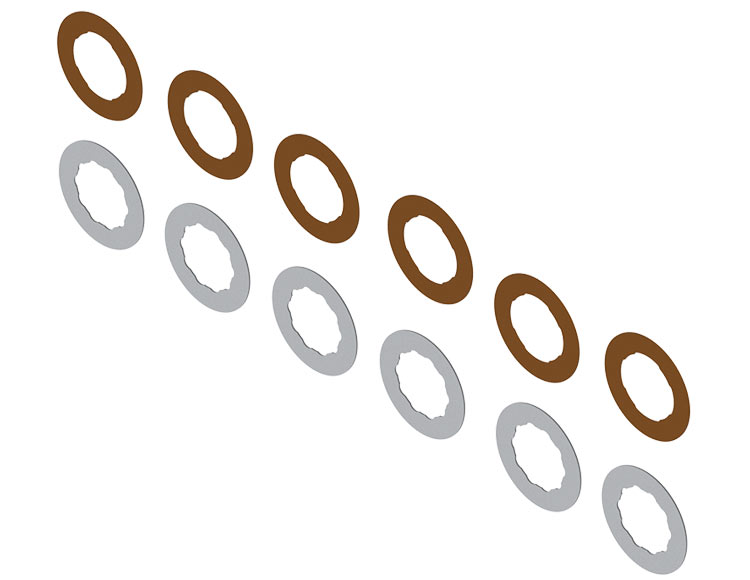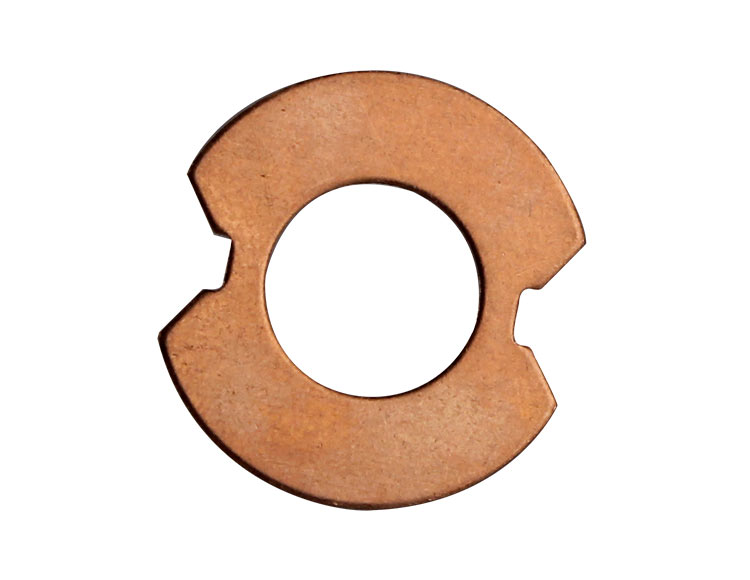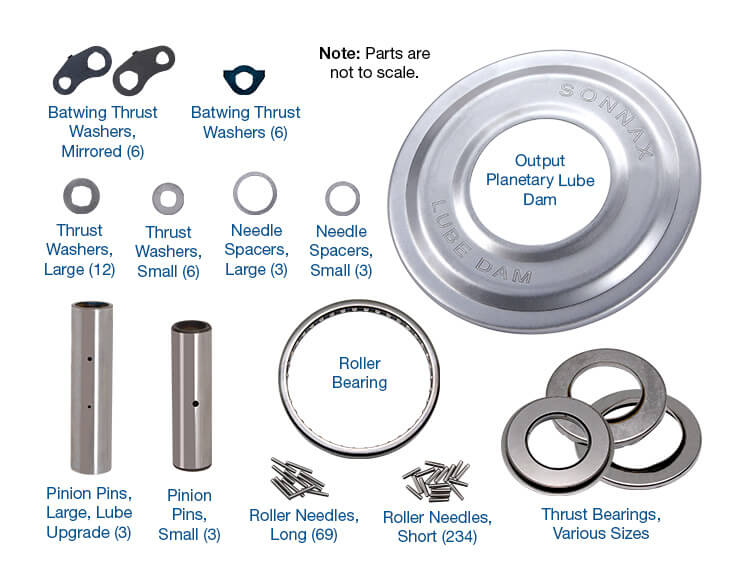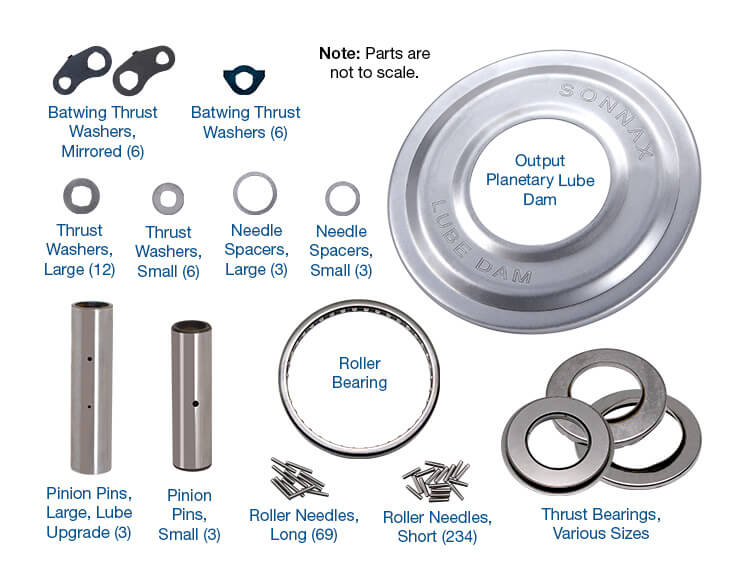In order to remain competitive, many shops are offering
transmission warranties that are longer than the original new vehicle factory warranty! Due to the high cost, installing all new OEM planets is rarely a good option. Remaining options are limited to reusing the original parts; finding what you hope are good used parts; using someone else’s rebuilt parts; taking a chance on new aftermarket parts; or disassembling, inspecting and reassembling planets in your own shop.

There are degrees of risk with all of these options, but in-house rebuilding of planets is one of the best ways to control cost, quality and warranty exposure – especially when Sonnax has the quality parts you need for a lasting repair. Our needle bearings have dimensions specified in millionths of an inch. Our thrust washers meet or exceed the durability of OEM parts, including advanced PTFE-coated washers for some applications. Our pins and gears are manufactured to exacting hardness and bearing surface finishes. Our replacement captive bearings are high-quality Torrington® bearings. Figure 1 shows all the planets that can be repaired with Sonnax parts and see chart on page 189 for a comprehensive list of all Sonnax planet components.
In transmissions, space, weight and durability constraints are pushed to their limits. With modern high-torque, high-RPM engines, the transmission ratings have increased. For example, the same basic planet system used in the old TH400 is now rated at 885 lb-ft maximum gearbox torque and 22,000 lb. maximum gross combined vehicle weight in the
4L80-E!

Do planets wear? You bet they do, but a wiggle test with fingers calibrated by experience cannot detect degrading pins or needles. Just as we can’t see the dark side of the moon, many times we can’t see or even detect pinion pin wear without disassembling the planet. Amazingly, the parts in Figure 2 felt smooth and tight as a new planet, yet the pins and needles were badly worn.
Fortunately, servicing the 4L80-E overdrive planet does not involve pin swedging. It is just a matter of inspecting and replacing the worn pieces. For swedged-in-place pins, you can disassemble by pushing the pin straight through with a press, or drill out one end of the pin to weaken the factory crimp and minimize the stress on the carrier as the old pin is pushed out. But disassembling the planet is the easy part – it’s getting it all back together that’s the hard part, and even when swedging the pins is not required, dealing with a loose jumble of needle bearings is about as inviting as a varnished and contaminated valve body first thing in the morning.
Like other areas in transmission rebuilding we’re all looking for the easiest solution – you know, “Just tell me what I need to do.” I wish I could say we had all the tools, fixtures and detailed instructions for recrimping planet pins for all applications.

At Sonnax this is something we are working on, but the reality is you will have to get creative in setting up fixtures to service the planets you work on most often. What we do have are quality parts and some tips to help you get past the major hurdles in setting up a planet service center in your shop.
So, what’s the trick for swedging planet pins in place? Forget any memories you have of using a hammer and punch. That method leaves too much room for error. Some larger rebuilders use a commercial floor-standing riveter to crimp pins in place. However, a typical hydraulic H-press has proven to be a consistent and practical method for getting the job done. You can use your existing shop press, or pick up one of the newer low-cost bench-top presses. For greater consistency it is best to add an accurate pressure gauge with a T-fitting to supplement the existing tons gauge. Be sure to take all necessary safety precautions that go along with using a powerful press.
There are degrees of risk with all of these options, but in-house rebuilding of planets is one of the best ways to control cost, quality and warranty exposure – especially when Sonnax has the quality parts you need for a lasting repair. |
The press shown in
Figure 3 is being used to swedge pins in a
4T65-E input planet. If you’re just after replacing the captured bearing that commonly fails, then only two pinions have to be removed to install Sonnax bearing
34821-01 and the only other parts needed are two Sonnax
34875-02 replacement pins.
For forming the crimps, there is a swedge-forming tool available from Allison. (See Figure 4 for tool and example of pin that was swedged with 3 tons of pressure in the press and Figure 5 for picture of the 4T65-E planet with two new pins swedged in place after replacing the captured bearing.) The results are a neat OEM-style swedge that swells and forms the end of the pin. This one tool can be adapted to a number of different applications and pin diameters. For a more economical alternative, cross-shaped concrete chisels come in many sizes and are adaptable to swedging the pins.
Crimping pins with a hammer and staking tool was never a procedure that instilled confidence. There was always that nagging feeling that if not done perfectly the planet would be a time bomb waiting to create an expensive comeback. With the control and consistency that come with using the hydraulic press and the appropriate crimping tool, pinswedging becomes a confidence-inspiring procedure that can become routine in your shop.

Sonnax & Powerglide
Sonnax offers a complete line of
Powerglide planet components, including our new ultimate Gear Sets.
Figure 6 at right shows a polished gear tooth section and the uniform depth of case hardness from the tip of the tooth to the tooth root. Due to the varying heat absorption of the different thicknesses of a tooth, obtaining this level of consistent case hardness on gear teeth requires state-of-the-art processes. By controlling and verifying the depth of case hardness, Sonnax Powerglide components provide both maximum strength and maximum wear resistance.
Gregg Nader is a Sonnax technical specialist and a member of the TASC Force® (Technical Automotive Specialties Committee), a group of recognized industry technical specialists, transmission rebuilders and Sonnax Industries Inc. technicians.













